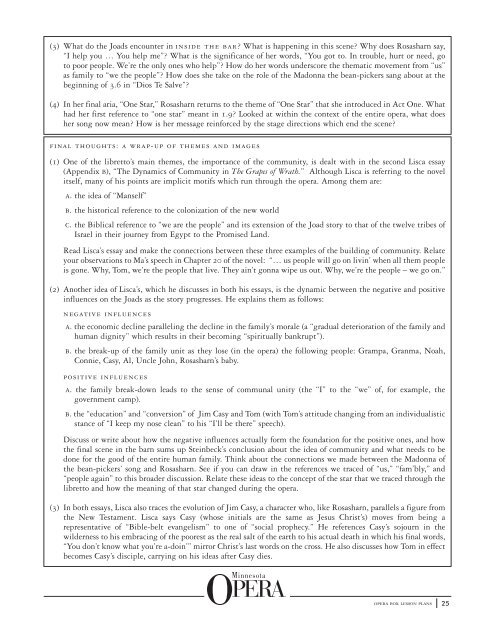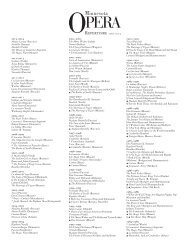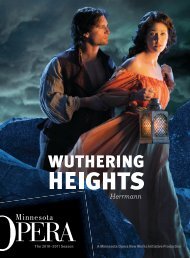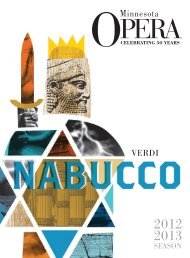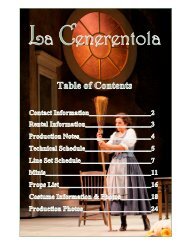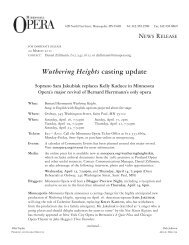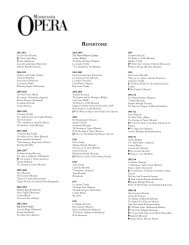You also want an ePaper? Increase the reach of your titles
YUMPU automatically turns print PDFs into web optimized ePapers that Google loves.
(3) What do the Joads encounter in inside the bar? What is happening in this scene? Why does Rosasharn say,<br />
“I help you … You help me”? What is the significance of her words, “You got to. In trouble, hurt or need, go<br />
to poor people. We’re the only ones who help”? How do her words underscore the thematic movement from “us”<br />
as family to “we the people”? How does she take on the role of the Madonna the bean-pickers sang about at the<br />
beginning of 3.6 in “Dios Te Salve”?<br />
(4) In her final aria, “One Star,” Rosasharn returns to the theme of “One Star” that she introduced in Act One. What<br />
had her first reference to “one star” meant in 1.9? Looked at within the context of the entire opera, what does<br />
her song now mean? How is her message reinforced by the stage directions which end the scene?<br />
final thoughts: a wrap-up of themes and images<br />
(1) One of the libretto’s main themes, the importance of the community, is dealt with in the second Lisca essay<br />
(Appendix B), “The Dynamics of Community in The <strong>Grapes</strong> of Wrath.” Although Lisca is referring to the novel<br />
itself, many of his points are implicit motifs which run through the opera. Among them are:<br />
A. the idea of “Manself”<br />
B. the historical reference to the colonization of the new world<br />
C. the Biblical reference to “we are the people” and its extension of the Joad story to that of the twelve tribes of<br />
Israel in their journey from Egypt to the Promised Land.<br />
Read Lisca’s essay and make the connections between these three examples of the building of community. Relate<br />
your observations to Ma’s speech in Chapter 20 of the novel: “… us people will go on livin’ when all them people<br />
is gone. Why, Tom, we’re the people that live. They ain’t gonna wipe us out. Why, we’re the people – we go on.”<br />
(2) Another idea of Lisca’s, which he discusses in both his essays, is the dynamic between the negative and positive<br />
influences on the Joads as the story progresses. He explains them as follows:<br />
negative influences<br />
A. the economic decline paralleling the decline in the family’s morale (a “gradual deterioration of the family and<br />
human dignity” which results in their becoming “spiritually bankrupt”).<br />
B. the break-up of the family unit as they lose (in the opera) the following people: Grampa, Granma, Noah,<br />
Connie, Casy, Al, Uncle John, Rosasharn’s baby.<br />
positive influences<br />
A. the family break-down leads to the sense of communal unity (the “I” to the “we” of, for example, the<br />
government camp).<br />
B. the “education” and “conversion” of Jim Casy and Tom (with Tom’s attitude changing from an individualistic<br />
stance of “I keep my nose clean” to his “I’ll be there” speech).<br />
Discuss or write about how the negative influences actually form the foundation for the positive ones, and how<br />
the final scene in the barn sums up Steinbeck’s conclusion about the idea of community and what needs to be<br />
done for the good of the entire human family. Think about the connections we made between the Madonna of<br />
the bean-pickers’ song and Rosasharn. See if you can draw in the references we traced of “us,” “fam’bly,” and<br />
“people again” to this broader discussion. Relate these ideas to the concept of the star that we traced through the<br />
libretto and how the meaning of that star changed during the opera.<br />
(3) In both essays, Lisca also traces the evolution of Jim Casy, a character who, like Rosasharn, parallels a figure from<br />
the New Testament. Lisca says Casy (whose initials are the same as Jesus Christ’s) moves from being a<br />
representative of “Bible-belt evangelism” to one of “social prophecy.” He references Casy’s sojourn in the<br />
wilderness to his embracing of the poorest as the real salt of the earth to his actual death in which his final words,<br />
“You don’t know what you’re a-doin’” mirror Christ’s last words on the cross. He also discusses how Tom in effect<br />
becomes Casy’s disciple, carrying on his ideas after Casy dies.<br />
opera box lesson plans<br />
25


